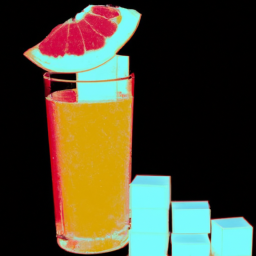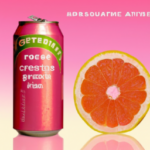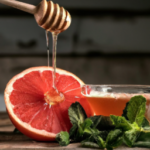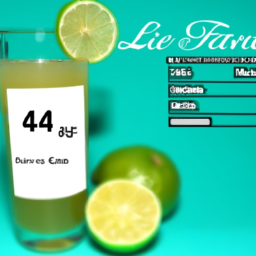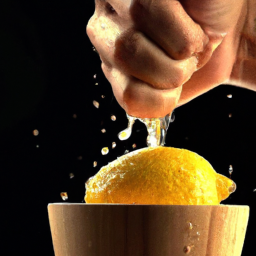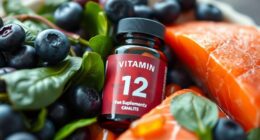I have always loved the tangy and refreshing taste of grapefruit juice, and it has been a great way to start my mornings. However, I have recently become more mindful of my sugar consumption and have started to wonder about the actual sugar levels in the grapefruit juice that I love.
After doing some research, I found that the answer isn’t as straightforward as I thought – there are a lot of factors that contribute to the amount of sugar in grapefruit juice.
In this article, we’ll explore the basics of sugar, the nutritional value of grapefruit juice, and the amount of sugar in grapefruit juice. We’ll also take a look at the glycemic index of grapefruit juice and the health effects of sugar.
Additionally, we’ll compare the sugar content of grapefruit juice to other beverages and offer some tips for reducing sugar intake. Finally, we’ll discuss alternatives to grapefruit juice for those who are looking to cut back on their sugar consumption.
Key Takeaways
- Grapefruit juice contains naturally occurring sugar, with 24g per cup.
- Compared to other juices, grapefruit juice has significantly less sugar and a low glycemic index.
- Diluting with water or opting for sugar-free options can reduce sugar intake when drinking grapefruit juice.
- Excessive consumption of sugar can lead to various health issues, and natural sweeteners like honey and stevia are healthier options than sugar.
Understanding the Basics of Sugar
You’ll need to understand the basics of sugar if you want to know how much of it is in grapefruit juice. Sugar is a type of carbohydrate that’s naturally found in many foods, including fruits, vegetables, and dairy products.
There are two main types of sugar: glucose and fructose. Glucose is the primary source of energy for our bodies, while fructose is sweeter and found in fruits like grapefruit.
However, there are also many different types of sugar substitutes that are used to sweeten foods and drinks without the calories of regular sugar. These include artificial sweeteners like aspartame and saccharin, as well as natural options like stevia and honey.
It’s important to keep in mind that sugar substitutes may not be as healthy as they seem and may have negative effects on our bodies in the long run. With this in mind, let’s move on to the nutritional value of grapefruit juice.
The Nutritional Value of Grapefruit Juice
Feeling energized and refreshed after sipping on this citrusy elixir, it’s clear that grapefruit juice is a powerhouse of essential vitamins and minerals. Not only is it low in calories, but it’s also packed with nutrients like vitamin C, potassium, and antioxidants.
Grapefruit juice benefits include improving immune function, aiding in digestion, and reducing the risk of chronic diseases like heart disease and cancer.
In addition to its health benefits, grapefruit juice is also a versatile ingredient in many recipes. It can be used as a base for smoothies, mixed with other juices for a refreshing drink, or even used in marinades for meats. With its tangy and slightly bitter taste, grapefruit juice adds a unique flavor profile to any dish.
However, it’s important to note that while grapefruit juice is low in calories and high in nutrients, it does contain sugar.
The Amount of Sugar in Grapefruit Juice
It may come as a surprise to some, but grapefruit juice does contain a considerable amount of sugar. Here are 5 things to keep in mind when it comes to the sugar content of grapefruit juice:
- One cup of unsweetened grapefruit juice contains about 24 grams of sugar, which is equivalent to 6 teaspoons of sugar.
- The sugar in grapefruit juice is naturally occurring, rather than added like in many processed foods and beverages.
- While grapefruit juice does contain sugar, it also has many health benefits, such as being high in vitamin C and antioxidants.
If you’re looking to reduce your sugar intake, consider diluting your grapefruit juice with water or opting for sugar-free grapefruit juice options. It’s important to remember that moderation is key when it comes to consuming grapefruit juice or any other sugary beverage.
When it comes to grapefruit juice, there are ways to enjoy its flavor and benefits without consuming too much sugar. In the next section, we’ll explore the glycemic index of grapefruit juice and how it affects blood sugar levels.
The Glycemic Index of Grapefruit Juice
By understanding how grapefruit juice affects your blood sugar levels through its glycemic index, you can make informed choices about incorporating it into your diet. The glycemic index (GI) is a measure of how quickly and how much a food raises blood sugar levels.
The GI of grapefruit juice is relatively low, around 25, which means it has a minimal impact on blood sugar levels. This low GI can have benefits for those looking to manage their blood sugar levels, such as people with diabetes. It can also aid in weight loss efforts, as foods with a low GI have been shown to keep you feeling fuller for longer periods of time.
However, it’s important to note that while grapefruit juice may have a low GI, it still contains sugar and should be consumed in moderation as part of a balanced diet. Understanding the impact of grapefruit juice on your blood sugar levels can help you make informed choices about how to incorporate it into your diet.
Moving on to the subsequent section about the health effects of sugar, it’s important to note that while grapefruit juice may have a low GI, it still contains sugar. Excessive consumption of sugar can have negative impacts on overall health and wellbeing.
The Health Effects of Sugar
Consuming excessive amounts of sweeteners in our diet can have detrimental effects on our overall health and well-being. Sugar addiction is a real problem that many people face, and it can lead to a host of health issues, from obesity and diabetes to heart disease and cancer.
Unfortunately, sugar is hidden in many of the foods and drinks we consume on a daily basis, including grapefruit juice. While grapefruit juice may seem like a healthy choice, it can contain a high amount of added sugars, which can contribute to our daily sugar intake.
It’s important to be aware of hidden sugar sources in our diet and make conscious choices to limit our intake. This can mean reading nutrition labels and choosing products with lower sugar content, or swapping out sugary drinks like grapefruit juice for water or unsweetened alternatives.
By doing so, we can reduce our risk of developing health issues associated with sugar consumption and improve our overall well-being.
As we move into the subsequent section about how sugar affects the body, it’s important to understand the impact that sugar can have on our physical and mental health.
How Sugar Affects the Body
When we indulge in sugary treats, our bodies experience a rush of pleasure and energy that can quickly turn into a crash. This is because sugar affects the body in various ways. First, it causes a spike in blood sugar levels, which triggers the release of insulin. This hormone helps to transport sugar from the bloodstream to the cells, where it’s used for energy. However, when we consume too much sugar, our cells become resistant to insulin, which results in high blood sugar levels and a host of health problems, including type 2 diabetes.
In addition to its impact on blood sugar levels, sugar also affects our mood and skin health. When we consume sugar, it triggers the release of dopamine, a neurotransmitter that’s associated with pleasure and reward. This is why we feel good after eating sugary foods. However, too much sugar can also lead to mood swings, irritability, and anxiety. Moreover, sugar can contribute to the development of acne and other skin problems by triggering inflammation and disrupting the balance of bacteria in our gut.
As we move on to comparing the sugar content of grapefruit juice to other beverages, it’s important to note that the impact of sugar on our bodies goes beyond just calories and grams. The quality and source of the sugar matter as well.
Comparing Sugar Content of Grapefruit Juice to Other Beverages
Did you know that compared to other popular juice options, grapefruit juice contains significantly less sugar? While many fruit juices are high in sugar, grapefruit juice is relatively low in sugar content.
For example, a 12-ounce can of soda can contain up to 40 grams of sugar, while the same amount of grapefruit juice contains only 20 grams of sugar. This makes grapefruit juice a healthier alternative for those who want to watch their sugar consumption.
Other popular juice options also contain high amounts of sugar. For instance, a 12-ounce serving of orange juice may contain up to 33 grams of sugar, while cranberry juice can contain up to 30 grams of sugar in the same serving size.
Therefore, if you’re looking to reduce your sugar intake, switching to grapefruit juice is a smart choice. In the next section, I’ll provide tips for reducing sugar consumption without sacrificing taste.
Tips for Reducing Sugar Intake
Looking to improve your health and feel better? Here are some simple tips to cut down on your sugar intake and still enjoy delicious meals and snacks.
One of the easiest ways to reduce your sugar intake is by making healthy substitutions. For example, instead of using sugar in your coffee or tea, try using a natural sweetener like honey or stevia. You can also swap out sugary snacks for healthier options like fruit, nuts, or a piece of dark chocolate.
Another way to reduce your sugar intake is by cooking with sugar-free recipes. There are many websites and cookbooks that offer delicious and healthy recipes that don’t require any added sugars. You can also try experimenting with different spices and herbs to add flavor to your meals without using sugar.
By making these simple changes, you can significantly reduce your sugar intake and improve your overall health.
Now, let’s explore some alternatives to grapefruit juice.
Alternatives to Grapefruit Juice
You might be surprised to discover the variety of tasty options available as substitutes for grapefruit juice, each bringing a unique flavor to your breakfast routine. If you’re looking for a juice alternative that is low in sugar, there are several sugar-free options to choose from. One of my personal favorites is unsweetened cranberry juice, which has a tart and refreshing taste that pairs well with breakfast foods like eggs and toast.
Another great option is freshly squeezed lemon or lime juice, which can be mixed with water or sparkling water to create a citrusy, low-sugar drink. For those who prefer a sweeter flavor, apple cider vinegar mixed with water and a small amount of honey or stevia can provide a sweet and sour taste without the excess sugar found in many fruit juices. With so many juice alternatives and sugar-free options available, there’s no need to rely on grapefruit juice as your go-to breakfast beverage.
| Juice Alternative | Sugar Content (per 8 oz) |
|---|---|
| Grapefruit juice | 24 g |
| Unsweetened cranberry juice | 0 g |
| Freshly squeezed lemon juice | 0.6 g |
| Freshly squeezed lime juice | 1.3 g |
| Apple cider vinegar (with honey or stevia) | 4 g |
As you can see from the table above, there are several juice alternatives that have little to no sugar content, making them a great option for those looking to reduce their sugar intake. Whether you prefer a tart or sweet flavor, there is a juice alternative out there to suit your taste preferences. So next time you’re reaching for a glass of grapefruit juice, consider trying one of these sugar-free options instead.
Frequently Asked Questions
Can grapefruit juice be consumed by diabetics?
As a diabetic, I can consume grapefruit juice in moderation as it has a low glycemic index and contains valuable nutrients such as vitamin C and potassium. However, it is important to monitor sugar intake and consult with a healthcare provider.
Does the sugar in grapefruit juice affect weight loss efforts?
Cutting back on sugar intake can aid in weight management. Grapefruit juice contains natural sugar, but consuming it in moderation as part of a balanced diet may not significantly affect weight loss efforts.
Is there a difference in sugar content between freshly squeezed grapefruit juice and store-bought varieties?
Freshly squeezed grapefruit juice generally has a higher nutritional value than store-bought varieties due to the lack of added sugars and preservatives. However, it’s important to note that both types of juice can vary in sugar content.
Are there any potential side effects of consuming too much sugar from grapefruit juice?
Consuming too much sugar from grapefruit juice can lead to potential health risks such as weight gain, tooth decay, and increased risk of diabetes. The recommended daily intake for added sugars is no more than 25 grams per day.
How does the sugar content in grapefruit juice compare to other citrus juices like orange or lemon juice?
As a citrus juice lover, I’ve compared the taste of grapefruit to other popular varieties. Apart from its unique tang, grapefruit packs a punch with its nutritional benefits, surpassing orange and lemon juice in vitamin C and antioxidant content.
Conclusion
So, how much sugar is in grapefruit juice? It depends on the brand and type, but on average, there are about 20 grams of sugar in an 8-ounce serving.
While this may seem like a high amount, it’s important to remember that the sugar in grapefruit juice is naturally occurring and comes from the fruit itself. Additionally, grapefruit juice has a low glycemic index, meaning it doesn’t cause a rapid spike in blood sugar levels.
However, it’s still important to be mindful of our sugar intake, as excessive sugar consumption can lead to health problems such as obesity, type 2 diabetes, and heart disease.
To reduce sugar intake, we can opt for unsweetened or low-sugar alternatives to grapefruit juice, such as water infused with citrus fruits or herbal tea.
Overall, while grapefruit juice contains some sugar, it can still be a healthy addition to a balanced diet when consumed in moderation.
Ilana has been a vegan for over 10 years. She originally made the switch for health reasons, but soon found herself becoming more and more passionate about the ethical and environmental implications of a vegan lifestyle. Ilana is the author of The Graceful Kitchen, a blog all about veganism. She loves to cook up delicious and nutritious vegan meals, and share her recipes with others who are interested in leading a cruelty-free life. Ilana is also a strong advocate for using whole foods as the foundation of a healthy diet, and believes that going vegan is one of the best ways to achieve this.
